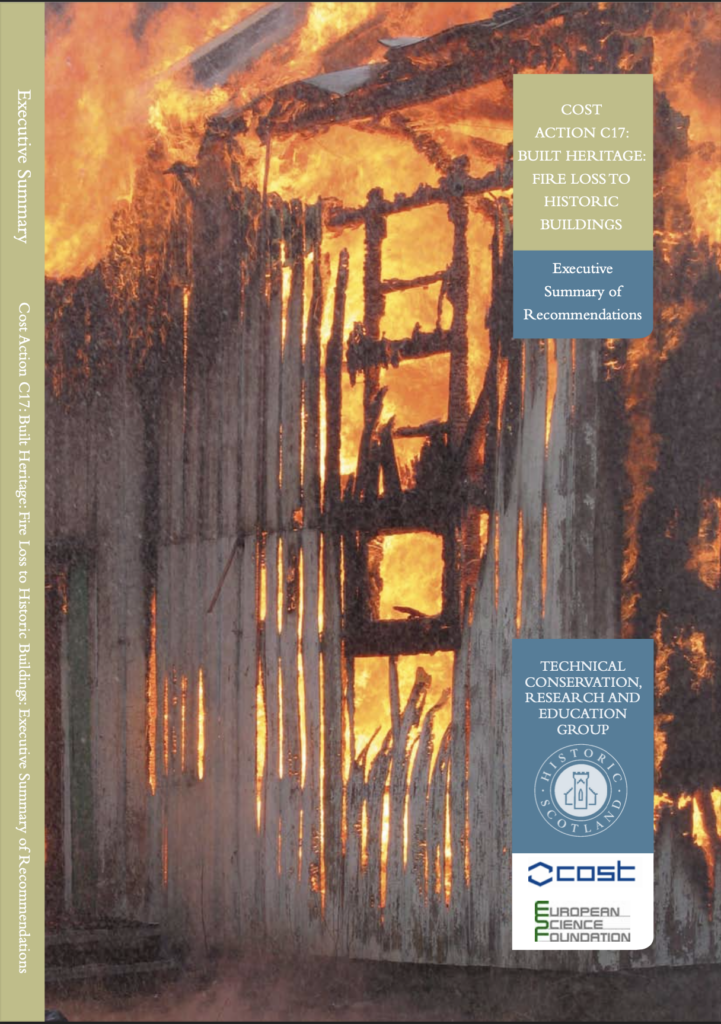Fire Loss to Historic Buildings – The Executive COST C17 Summary of Recommendations
This document promoted the implementation of a European concerted research approach, ultimately designated as “COST Action C17 Built Heritage: Fire Loss to Historic Buildings”, which was formally inaugurated in Brussels in December 2002.
Fire continues to be one of the greatest threats to our shared cultural heritage. The COST Action C17 Action (Built Heritage: Fire Loss to Historic Buildings 2002–2006) brought together experts from across Europe to study the problem of fire in historic buildings, share knowledge, and recommend practical solutions. Its findings (COST C17 Executive Summary) remain highly relevant for fire safety professionals working with cultural heritage today.
Why it Matters
Historic buildings face unique vulnerabilities:
- They are often built with combustible materials and outdated services.
- Many are located in remote areas, delaying fire service response.
- Routine activities — events, maintenance, even candles or faulty chimneys — create risks.
- Once lost, their cultural, emotional, and economic value cannot be replaced.
Yet, across Europe, consistent data on fire incidents in heritage buildings is scarce. This knowledge gap hampers risk assessment and strategic planning.
The C17 Approach
The Action set out four work streams:
- Data & Risk Statistics – Collecting evidence of heritage fire losses.
- Technology – Evaluating both traditional and modern fire protection methods.
- Cultural & Financial Value – Recognising the economic and societal costs of fire.
- Management Strategies – Developing property-level fire plans and damage limitation teams.
By combining engineering, conservation, and management perspectives, the project sought to balance safety needs with respect for historic fabric.
Knowledge Provided
- Trend Analysis: These tools enable the analysis of fire risk trends, which is crucial for identifying potential hazards.
- Statistical Comparisons: Statistical comparisons are more likely to be relevant to existing statistics on residential buildings, which are a significant portion of the listed objects.
- Risk Assessment Data: These tools provide access to risk assessment data, which is essential for informed decision-making and risk management.
Problems Addressed
- Inadequate Data: The existing data on fire risks may be incomplete or inaccurate, hindering effective analysis and management.
- Lack of Understanding: There may be a lack of understanding among stakeholders regarding the significance of fire risks to historic buildings.
- Inadequate Risk Management: Current risk management practices may not be sufficient to address the challenges posed by fire risks to historic buildings. Every building management organisation requires a clear indication of the priorities for building upgrades. As the existing data bank systems are national reports from several European countries, there is no possibility of comparing the categories used. Although empirical data are generally poor, conclusions can be drawn. The primary risks appear to be (covering 75% of all cases) providing useful assistance to building managers when prioritising their investments:
- Hot building and maintenance works (often in the attic area)
- Old electric wiring
- Open fires provided by neglect, occupants, and staff members (candles, smoking, etc.)
- Arson
Insurance Considerations
In pursuing these objectives, it was imperative to integrate and coordinate the associated factors to foster a shared understanding of the pertinent issues. To achieve substantial outcomes during the program’s intended lifespan, a strategic approach was adopted, emphasising the following key areas:
- Statistical Data Compilation: Comprehensive statistical data was gathered to assess the extent of heritage at risk.
- Statistical Research on Fire Consequences and Causes: In-depth statistical research was conducted to explore the consequences and causes of both major fires and minor incidents, including small fires that are not attended to by the fire brigade or false alarms. The impact of these incidents was also evaluated.
- Risk Assessment Data-Driven Dialogue: Utilising the risk assessment data gathered, a dialogue was established with insurance bodies to solicit the development of insurance products more specifically tailored to historic buildings.
- Well-Documented Survey of Technical Expertise: A comprehensive survey of up-to-date technical expertise was established to assist in influencing future developments in fire protection technology for historic buildings.
- Defining Appropriate Countermeasures: A well-defined range of passive and active technical equipment countermeasures was identified.
- Alternative Approaches to Mitigating Loss Levels: Alternative approaches to effectively stemming current loss levels were explored.
- Conferences and Workshops: A series of conferences and workshops were organised to foster the development of effective risk assessment techniques and risk mapping using insurance company data and other relevant information.
- Promotion of Findings and Benefits: Relevant risk assessment methodologies and property management support were promoted.
- Knowledge Dissemination: Know-how was disseminated through the publication of proceedings and recommendations.
Key Findings & Recommendations
1. Data and Risk Awareness
- National fire reporting systems rarely capture the scale of heritage loss.
- Countries should develop heritage-specific fire databases (the Scottish model was highlighted).
- Minor incidents and near misses should also be logged to strengthen prevention strategies.
2. Technology in Historic Buildings
- Fire protection systems must be:
essential, risk-appropriate, compliant, minimally invasive, sensitively integrated, and reversible. - Successful examples of discreetly installed detection and suppression systems should be shared as good practice.
3. Valuing Heritage
- Decisions about reconstruction after a fire should weigh cultural, historic, and emotional values alongside economic costs.
- Governments should reinvest tourism revenues into safeguarding heritage assets.
- Insurance for historic buildings must be rethought: cover levels are often inadequate, and terms should allow the use of traditional materials in recovery.
4. Operational framework
The operational framework of the Action was developed to consider the special nature of the value of historic buildings, the economic aspects of cultural historic value, and the need for measures to minimise damage if a fire occurs. Specifically this required consideration of the:
• vulnerability of historic buildings to fire
• risk assessment methodologies
• protection of fabric and content
• prevention of fire and fire spread
• detection and suppression requirements
• training and management of staff
• insurance considerations
5. Management and Preparedness
- Every historic property should have a fire safety handbook and damage limitation plan, including:
- Emergency contacts and salvage priorities.
- Plans for object removal and safe storage.
- Training records and maintenance logs.
- Collaboration with fire services is critical: first responders often arrive without knowing a site’s heritage status.
- Terminology matters: “damage limitation” is preferred over “salvage” to emphasise proactive planning before, during, and after an incident.
Lessons for Today
The C17 Action closed in 2006, but its conclusions remain strikingly current:
- Heritage fire data is still patchy.
- Balancing safety with conservation requires sensitive design and reversible systems.
- Insurance, funding, and political frameworks often undervalue cultural assets.
- Above all, preparedness and knowledge-sharing between owners, conservation professionals, insurers, and fire services is the most powerful tool we have.
Final Thought
COST Action C17’s central objective was to define, at a European level, the extent of loss to built heritage resulting from fire and to promote remedial actions and recommendations for combating these using minimally invasive techniques.
COST C17 proved that a multi-disciplinary, European-wide approach is both possible and effective. For today’s fire safety professionals, the message is clear: we must integrate engineering, conservation, and management to safeguard heritage buildings — because once fire takes hold, prevention is always better than recovery.
Some COST C17 Publications
The Final Report brochure of the Cost Action C17 may be downloaded from this post: COST Final Report Brochure
- A presentation on a fire protection system suitable for cultural heritage buildings, based on the utilisation of oxygen-depleted atmospheres, is the Hypoxic Air system. This system has been presented at the Cost C17 Action meetings. In particular, the downloadable document on Inert Air (presented during the joint NFPA – Cost C17 action meeting held in Ljubljana on May 2006) contains valuable information about this system. The presentation was delivered by Geir Jensen (COWI AS, Norway) and Jan Holmberg (Department of Building Sciences, Royal Institute of Technology, Sweden): Inert_Air_Presentation_for_COST_C17_Ljubljana_May_2006
- Sprinkler systems are prevalent in commercial and industrial buildings. However, their use in cultural heritage buildings raises concerns. Unintentional activations can damage paper documents and other artefacts that require moisture protection. Consequently, the reliability of sprinklers in such buildings is crucial for developing an effective strategy against fire.The paper titled “Analysis of Sprinkler Failures in Listed Heritage Buildings: Analysis of Unintended Activations of Water-Based Extinguishing Systems in Norwegian Heritage Buildings” was authored by Geir Jensen, Arvid Reitan, and John Ivar Utstrandf for the Riksantikvaren (The Norwegian Directorate for Cultural Heritage – RNDCH). This paper was presented during the Cost C17 Action (Fire Loss to Built Heritage). It is available for download through this link: Riksvantikvaren Analysis of Sprinkler Failures in Listed Heritage Buildings
- The COST Action C17 Working Group (WG) provides an overview of the current experience and presents fundamental knowledge on water mist technology for the heritage community. The WG outlines the challenges, implications, and perspectives of this technology to ensure the optimal protection of European heritage. A guide on how to assess and approve mist systems in heritage is provided in the white paper (dated July 2004) issued by Riksantikvaren – The Norwegian Directorate for Cultural Heritage (RNDCH): Water Mist in Heritage Report 12 July 2004
- COST Action C17 “Built Heritage: Fire Loss to Historic Buildings” has contributed to gather a wide variety of publications about fire safety and fire risk assessment of historic buildings. In the downloadble document Part4_Pages_267-280 (which is one of the parts of the final proceedings of the Action) it is possible to find some of the Cost C17 proceedings Associated Publications.







